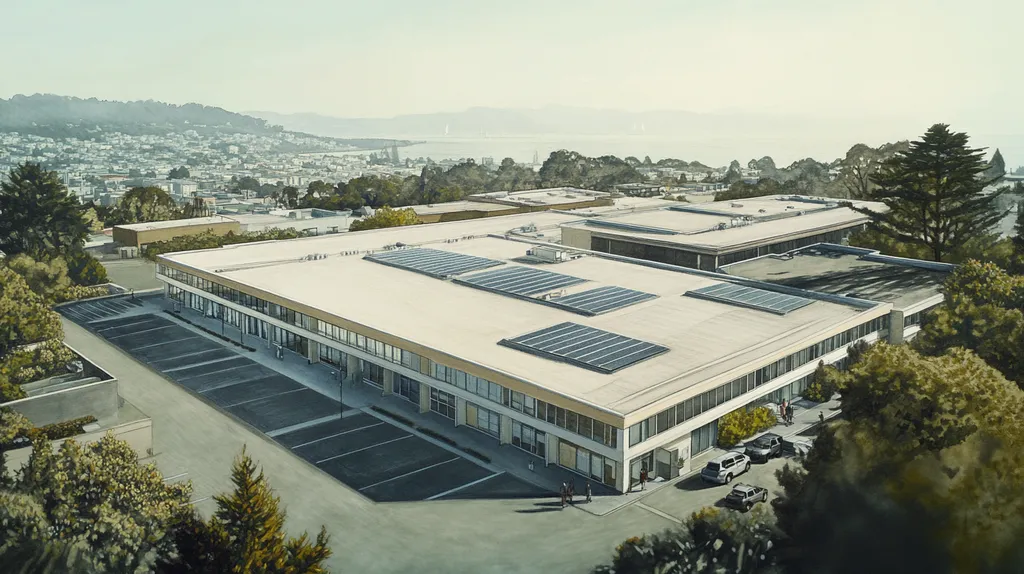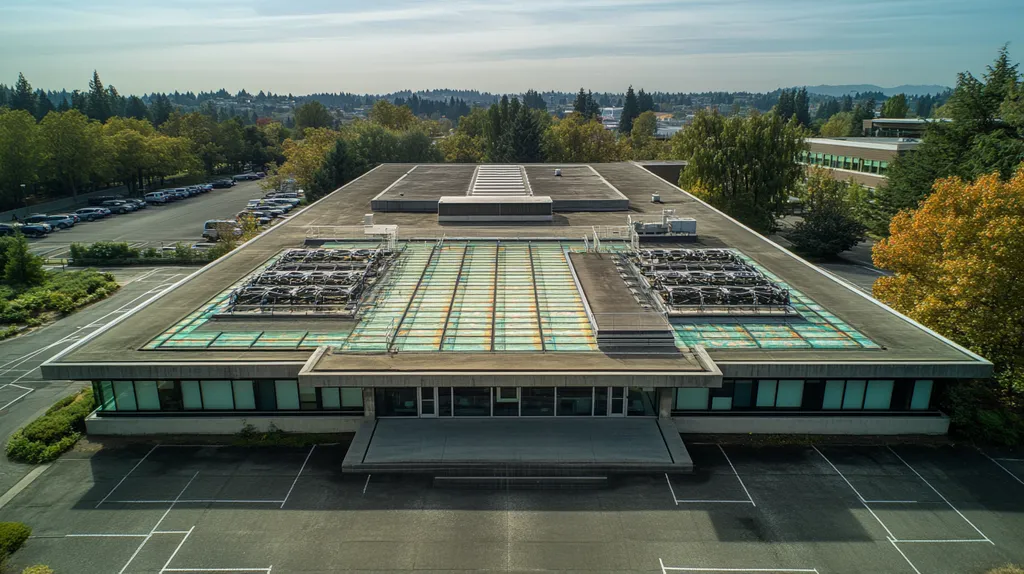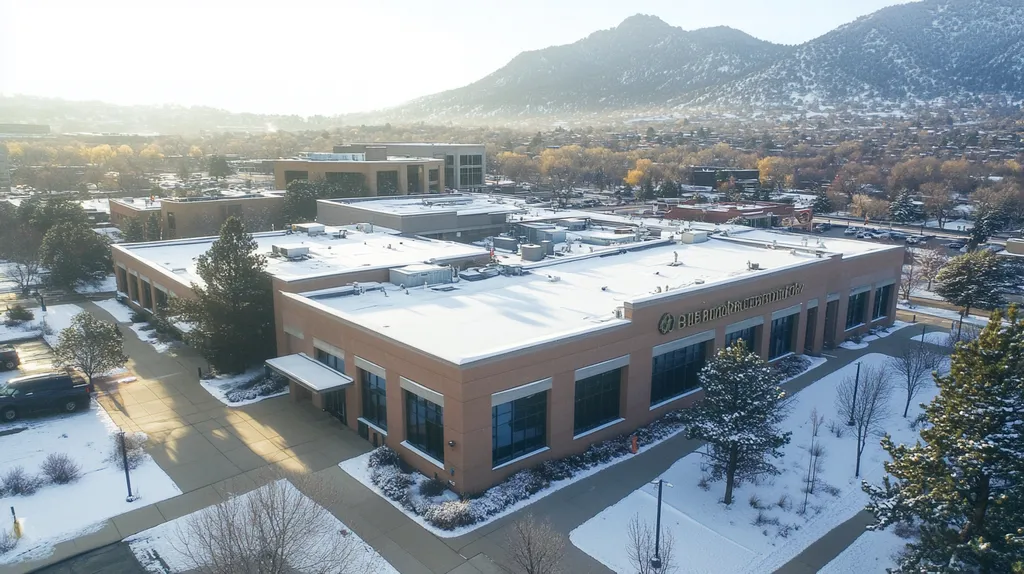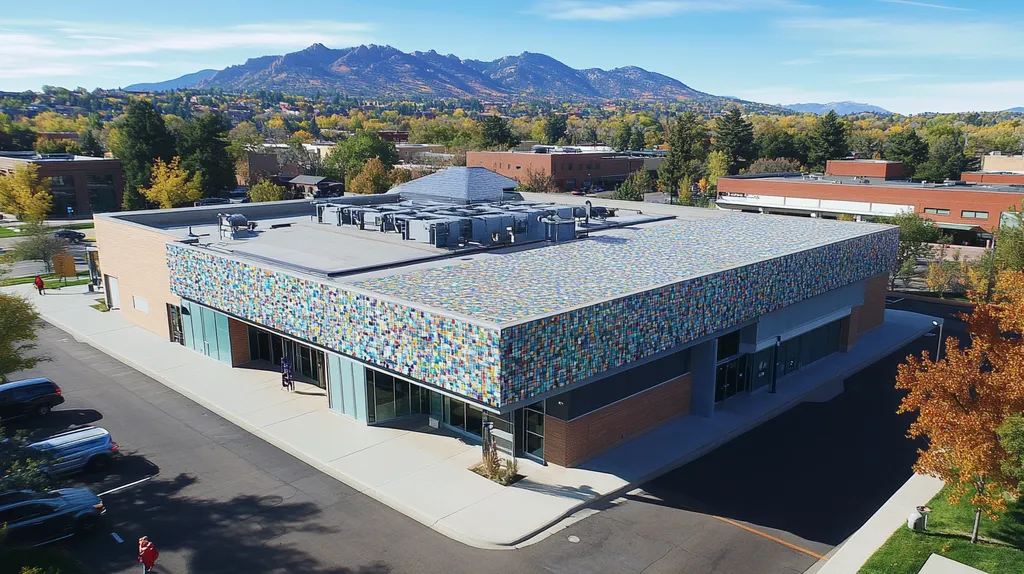In an era where industrial roofing costs have risen by 40% over the past decade, facility managers face mounting pressure to optimize their long-term roofing expenditures. Studies show that nearly 60% of commercial buildings experience preventable roof failures due to inadequate financial planning.
The complexity of modern roofing systems, coupled with evolving material technologies and stringent building codes, demands a comprehensive approach to expense management.
This guide examines critical aspects of industrial roof planning, from fundamental concepts and system components to maintenance protocols and performance metrics, providing facility managers with actionable strategies to protect their roofing investments.
SECTION 1: FUNDAMENTAL CONCEPTS
The state of an industrial roof not only protects the building itself but also plays a pivotal role in the overall efficiency of operations. Studies indicate that nearly 50% of commercial roofs face premature replacement due to a lack of foresight in planning. Understanding the lifespan and durability of roofing materials is essential for property owners and facility managers. This section will delve into the key aspects of roof longevity, an overview of common materials, and practical budgeting strategies for roofing expenses.
Understanding Roof Lifespan and Durability
The lifespan of an industrial roof can vary significantly based on several factors, including material choice, installation quality, and environmental conditions. Traditional materials like asphalt typically offer a lifespan of 15 to 20 years, while advanced options, such as TPO or EPDM, can last up to 30 years with proper maintenance.
Investing in high-quality materials and adhering to a regular inspection schedule can help prevent costly repairs down the line. Roof durability doesn’t solely hinge on the type of material; it also relies on structural design and local climate. For instance, roofs in humid regions may necessitate more frequent upkeep to prevent damage.
Establishing a proactive maintenance plan allows identification of potential issues before they escalate into costly repairs. This not only extends the roof’s usable life but also bolsters the building’s energy efficiency.
Grasping these fundamental concepts is crucial for maximizing return on investment and minimizing long-term expenses.
Types of Industrial Roofing Materials
There is a diverse array of materials available for industrial roofing, each offering unique advantages and disadvantages. Common choices include single-ply membranes, built-up roofs (BUR), and metal roofing systems. Single-ply membranes, particularly TPO and PVC, stand out for their lightweight properties and ease of installation.
While built-up roofs are celebrated for their durability, they often require more extensive maintenance as time goes on. Metal roofs, conversely, are renowned for their exceptional longevity and ability to withstand extreme weather, making them suitable for a wide range of climates.
When selecting roofing material, it is vital to consider not just initial costs but also factors such as lifespan, maintenance requirements, and resistance to weather elements. Opting for a durable material can help minimize replacements and repairs over time.
Moreover, familiarity with local building codes and regulations is essential to ensure that the chosen roofing materials comply with safety standards while delivering optimal performance.
Budgeting for Roof Expenditures
Creating a budget for roofing expenses demands a strategic mindset that includes initial installation costs, ongoing maintenance, and potential unexpected repairs. Many property owners tend to focus on upfront costs while overlooking the significance of planning for long-term financial implications.
A robust budget should encompass routine maintenance, which is vital for addressing minor repairs before they evolve into more significant issues. Setting aside funds for unforeseen repairs or replacements is equally crucial in maintaining financial stability.
Utilizing management software tools can simplify tracking expenses and assist in aligning roofing budgets with overall property management strategies. This comprehensive approach not only prepares facility managers for future expenses but also facilitates smooth operations.
Ultimately, effective budgeting centers on anticipating future financial needs rather than reacting to immediate circumstances. Adopting this proactive stance can lead to substantial savings and uninterrupted building performance.
SECTION 2: SYSTEM COMPONENTS
Grasping the various components of an industrial roofing system is critical for anticipating long-term expenses. A roof is only as strong as its weakest link; neglecting any part can lead to hefty financial repercussions. For instance, a study found that failing to properly maintain roofing membranes resulted in a staggering 30% increase in repair costs. This section will explore vital elements of industrial roofs, including roofing membranes, flashings, and structural integrity, highlighting their impact on overall expenses.
Roofing Membranes and Coatings
Roofing membranes act as the essential barrier against the elements, safeguarding the structure from weather-related damage. They play a pivotal role in maintaining a roof’s integrity and preventing costly leaks. Various membrane options, such as TPO, EPDM, and PVC, each come with distinct advantages and price points.
It’s important to note that not all membranes offer the same longevity; while TPO is recognized for its energy efficiency, it may require more frequent re-roofing compared to EPDM. Therefore, selecting the right membrane can significantly influence both the effectiveness and lifespan of a roof, ultimately affecting long-term costs.
Additionally, applying a coating system can further extend the lifespan of existing membranes. These coatings provide extra protection against ultraviolet rays and weather damage, which can significantly lower future repair expenses.
Property owners should proactively inspect membranes and coatings, as identifying wear early can prevent costly repairs in the future. Investing in durable membranes and regular maintenance is essential to alleviate long-term financial burdens.
Flashings, Gutters, and Downspouts
Flashings, gutters, and downspouts may seem minor, but they are crucial for directing water flow and securing roof seams. Proper drainage systems are vital to prevent water pooling that can result in extensive structural damage over time. A well-maintained drainage system can extend the roof’s lifespan while simultaneously cutting overall maintenance costs.
Choosing robust materials for flashings, like aluminum or stainless steel, is crucial. Inferior materials can corrode or fail, leading to leaks and potential water damage. Regular inspections and diligent maintenance of these components are essential for preserving the roof’s integrity.
Often, property managers overlook the significance of gutters and downspouts, leading to hazardous blockages. Clogged systems can result in expensive water damage, jeopardizing the building’s structure. A proactive maintenance approach toward these elements can save property owners from costly repairs and replacements.
Investing in quality flashings while routinely maintaining drainage systems is critical for reducing long-term roofing expenses.
Structural Integrity and Support
The structural integrity of an industrial roof is foundational for safety and longevity. A roof that lacks adequate support can lead to catastrophic failures and significant repair bills. Regular assessments of roof structures, including trusses and purlins, should be non-negotiable for facilities managers.
Over time, roofs may settle or suffer from moisture-related damage, which can compromise structural support. Delaying necessary structural repairs can lead to costs far exceeding immediate investments in maintenance and reinforcement.
Often, roofing issues are worsened by poor design or subpar materials used during installation. Selecting appropriate structural materials can bolster support, minimizing risks associated with weight loads and environmental stressors.
Maintaining structural integrity goes beyond safety; it is also a financial strategy. Preventive actions can lead to reduced repair bills and a notable extension of the roof’s overall life expectancy.
SECTION 3: IMPLEMENTATION METHODS
Planning for long-term expenses tied to industrial roofs is not just prudent; it’s essential for protecting investments. Studies show that neglecting regular assessments can spike long-term costs by 30% or more. Therefore, implementing structured assessment and maintenance plans is crucial to mitigate financial surprises. This section will delve into the importance of comprehensive roof assessments, effective repair strategies, and best practices for project scoping and budgeting, equipping stakeholders with valuable tools to effectively manage their roofing assets.
Comprehensive Roof Assessments and Inspections
Engaging in comprehensive roof assessments is paramount for grasping the current state of an industrial roof. Routine inspections pinpoint potential problems such as leaks or weaknesses in materials before they escalate. Without these evaluations, property owners risk facing significant, costly repairs that could have been avoided.
Establishing a regular inspection routine—ideally twice a year—empowers facilities managers to preemptively monitor wear and tear. Inspectors should concentrate on vulnerable areas like roof membranes, flashings, seams, and drainage systems. Detailed reports from these inspections guide repair prioritization and budgeting efforts.
Enhancing assessment accuracy can be achieved through visual inspections combined with moisture surveys and infrared scans. Infrared technology, for instance, uncovers hidden issues, allowing targeted repairs that save costs and extend a roof’s lifespan.
Ultimately, comprehensive assessments yield clear action plans that enable property owners to allocate resources wisely. Early problem detection safeguards both the roof’s integrity and the overall value of the building.
Strategies for Roof Rehabilitation and Repair
Timely rehabilitation and repair strategies are vital for any industrial roof’s longevity. Allowing minor issues to fester can lead to major problems, and thus, a proactive rehabilitation plan is necessary to mitigate such risks effectively.
For example, applying a roof coating could substantially extend the lifespan of aging roofs, shielding them from UV damage and weather-related wear. This method often proves more economical than a complete roof replacement while enhancing energy efficiency. Property owners should weigh options like elastomeric coatings or silicone membranes tailored to their roofs.
Additionally, regularly scheduled maintenance tasks—such as clearing gutters and drains—are essential for preventing water pooling and related damage. Prioritizing simple repairs like replacing damaged flashing or sealing leaks can stave off much larger issues down the road.
Keeping a detailed maintenance log helps track repairs and recurring problems. This information is invaluable for future roofing decisions, ensuring budget allocations align with the areas that need the most attention while extending the roof’s life.
Effective Project Scoping and Budgeting
Effective project scoping and budgeting are fundamental for managing long-term roofing expenditures successfully. A thoughtfully constructed budget ensures that funds are available for necessary repairs, alleviating financial stress. Inaccurate project scopes can lead to unexpected costs and delays.
To craft an effective budget, property owners should utilize insights gained from thorough inspections. This insight enables precise forecasting of repair needs alongside historical roofing performance data. Building relationships with reliable roofing contractors can also provide valuable guidance for realistic pricing.
A strategically placed contingency fund for unexpected repairs is also wise. Best practices suggest dedicating 10-15% of the overall budget as a cushion against unforeseen financial burdens, ensuring prompt responses to emergency roofing issues.
Lastly, routinely reviewing and adjusting the budget based on actual expenses and roofing condition helps maintain alignment with the facility’s evolving needs. This methodical approach not only protects roofing investments but also preserves the functionality of the building as a whole.
SECTION 4: MAINTENANCE REQUIREMENTS
Industrial roofs demand consistent maintenance to avert costly repairs and maximize their lifespan. Neglecting regular upkeep can spiral into significant financial burdens, with water damage alone costing property owners thousands each year. A proactive maintenance strategy is crucial for keeping the roof in peak condition. This section emphasizes the importance of preventative maintenance schedules, addresses climate impacts, and presents routine inspection protocols necessary for safeguarding roofing investments.
Preventative Maintenance Schedules
Establishing a robust preventative maintenance schedule is essential for any industrial roof. Regular upkeep adeptly captures minor issues before they burgeon into major problems, potentially saving thousands in repairs. A well-organized maintenance plan should encompass timelines for inspections, cleaning, and minor repairs.
For example, biannual inspections should be standard practice, allowing professionals to gauge the roof’s condition and address necessary work. Regularly cleaning drains and gutters serves as a vital defense against water pooling and subsequent damage. By adhering to a maintenance schedule, property owners can forecast roof service life and associated expenses with greater accuracy.
Documenting maintenance activities enriches the roof’s reliability. Keeping track of repair costs, inspection outcomes, and completed work provides insights into trends that can inform future budgeting decisions. Clear records illuminate the effectiveness of management strategies in safeguarding the roof’s integrity.
In summary, maintaining a consistent preventative maintenance schedule not only extends the roof’s lifespan but also fortifies the structural security of the entire facility.
Addressing Climate and Weather Factors
Climate and weather conditions profoundly shape the maintenance demands of an industrial roof. Extreme temperatures, heavy rainfall, and strong winds can impose substantial strain on roofing materials, leading to accelerated wear and tear. Recognizing these factors is critical for property owners dedicated to protecting their investment.
For instance, in regions afflicted by heavy snowfall, removing dense snow buildup is crucial to prevent excessive weight that could compromise the roof’s structure. Likewise, in areas subject to high winds, securing loose materials and ensuring proper installation defend against potential damage.
Post-storm evaluations give property owners the opportunity to conduct detailed assessments. These reviews enable timely repairs that mitigate the risks of leaks or structural failures. If neglected, weather-related damage can escalate repair costs and disrupt business operations.
By tailoring maintenance practices to reflect local climate conditions, owners can bolster the roof’s performance and durability, paving the way for reduced long-term expenses.
Routine Inspection and Repair Protocols
A systematic approach to routine inspections and repairs is crucial for ensuring optimal roof maintenance. Regular assessments by qualified professionals can pinpoint vulnerabilities before they develop into costly failures. Facilities managers should aim to create a comprehensive checklist for these inspections.
This checklist should include key details such as cracks, blisters, and membrane tears. Careful inspection of flashings and seals also aids in preventing leaks, a common concern that can lead to significant water damage. Tracking these critical indicators empowers management to address issues promptly.
In addition to inspections, having a rapid repair protocol is vital. Property owners should prioritize immediate execution of minor repairs to prevent escalation of issues. Cultivating relationships with reliable roofing contractors can enhance service speed and improve response times during emergencies.
Committing to routine inspections and effective repair protocols creates a solid foundation for maintaining the integrity of industrial roofs, reducing unexpected costs and extending the life of these vital investments.
SECTION 5: PERFORMANCE METRICS
Evaluating performance metrics is critical for property owners and facility managers dealing with industrial roofs. Ignoring roof performance can lead to unexpected costs and a shortened lifespan. In fact, a staggering 80% of roofing failures can be traced back to inadequate monitoring practices. Recognizing key performance metrics—such as roof condition, energy efficiency, and regulatory compliance—paves the way for informed decision-making that can significantly impact long-term expense planning.
Evaluating Roof Condition and Service Life
Regular assessments of the roof’s condition and projected service life are vital for effective long-term planning. Property owners should schedule routine inspections to identify wear and potential failure points early. While the average commercial roof has a lifespan of about 20 years, various factors—including maintenance habits, weather conditions, and material quality—can greatly influence that duration.
The use of advanced technology, such as thermal imaging and moisture surveys, can uncover hidden problems before they grow into significant issues. A proactive stance not only helps to extend the roof’s life but also minimizes the risk of costly repairs. Investing in scheduled maintenance is essential to prevent disruptive leaks and unexpected expenses.
Maintaining detailed documentation of inspections and repairs creates a performance history that aids in future budgeting. Accurate record-keeping allows property owners to forecast when significant replacements may be required, enabling better financial planning. Without this insight, they risk encountering unforeseen expenses that can strain budgets considerably.
Furthermore, analyzing performance trends over time facilitates objective evaluations of maintenance efficacy. Thus, the integration of regular evaluations directly correlates with improved roof performance and overall sustainability.
Energy Efficiency and Cost Savings
Energy efficiency serves as a compelling argument for focusing on performance metrics in roofing. Poorly optimized roofs can account for up to 30% of a building’s operating costs through energy expenditures. Adopting reflective roofing systems can lead to cooling cost reductions of up to 20%, resulting in measurable savings over time.
By closely monitoring energy performance, property owners can identify areas ripe for improvement. Embracing energy-efficient solutions not only benefits the environment but also has direct implications for a company’s financial health. Lower energy costs can free up resources for other potential investments.
In addition, long-term energy savings can elevate the property’s market value, increasing its appeal to future buyers or tenants. Such roofs might also be eligible for tax incentives or rebates, further enhancing their financial sustainability. Thus, considering energy metrics becomes essential for informed decision-making.
Ultimately, investing in energy-efficient roofing solutions yields a reduction in overall lifetime costs. The return on investment often surpasses the initial expenditures, underscoring the need to integrate energy performance metrics into long-term planning efforts.
Compliance with Industry Standards
Compliance with industry standards is vital for industrial roofing projects. Adhering to established safety and performance regulations ensures that the roof will operate optimally and legally. Ignoring compliance can lead to hefty fines and potential legal challenges, presenting significant financial burdens for property owners.
Regular assessments are necessary to ensure that roofing systems adhere to local, state, and federal standards. Certifications such as UL, FM, and Energy Star showcase compliance and are critical for avoiding possible liabilities. Since building codes and standards are frequently updated, ongoing education for decision-makers is crucial.
Moreover, compliance not only enhances building safety by reducing the risk of accidents related to roofing failures but also can positively influence insurance premiums and liability exposure. This makes robust risk management an essential element of long-term planning.
A commitment to compliance can also position property owners favorably in a competitive market. Well-maintained and compliant roofs attract potential tenants and buyers, bolstering opportunities for favorable lease terms or property sales.
SECTION 5: PERFORMANCE METRICS
Understanding performance metrics is not just beneficial; it is essential for property owners and facility managers overseeing industrial roofs. Ignoring roofing performance can lead to unexpected expenses, putting financial strains on budgets and prolonging building issues. Studies indicate that 80% of roofing failures can be traced back to insufficient monitoring practices. Key performance metrics—such as roof condition, energy efficiency, and compliance with industry standards—offer vital insights to support informed planning for long-term costs and maintenance.
Evaluating Roof Condition and Service Life
Regular evaluations of roof condition and service life are paramount for informed long-term planning. Property owners should conduct routine inspections to catch early signs of wear and potential failures. While the typical lifespan of a commercial roof is around 20 years, factors such as maintenance practices, weather exposure, and material selection can substantially influence durability.
Innovative technologies like thermal imaging and moisture surveys can reveal hidden issues before they escalate into serious concerns. A proactive approach not only prolongs the roof’s life but also helps prevent costly repairs, maintaining steady operations for the facility. This strategy minimizes the risk of disruptive leaks and unexpected expenditures.
Maintaining thorough documentation of inspections and repairs creates a valuable performance history that informs future budgeting. By accurately tracking this information, property owners can predict when major replacements are likely needed, ensuring adequate financial resources are available when the time comes. Neglecting documentation can lead to an unpleasant surprise of unexpected costs that strain financial plans.
Lastly, consistently comparing conditions over time allows property managers to objectively assess the effectiveness of their maintenance strategies. Thus, making regular evaluations a priority directly correlates to improved roof performance and sustainability.
Energy Efficiency and Cost Savings
Energy efficiency plays a critical role in evaluating performance metrics for an industrial roof. Without optimization, energy costs can account for up to 30% of a building’s operating expenses. Installing reflective roofing systems can lead to cooling cost reductions of as much as 20%, which translates into significant savings over time.
By monitoring energy performance, property owners can identify areas for potential improvement and capitalize on them. Opting for energy-efficient solutions doesn’t just contribute to environmental sustainability; it also translates directly to a stronger financial bottom line. Lower energy costs can free up funds for other essential investments, enhancing overall asset value.
In addition to immediate cost benefits, long-term energy savings can bolster the property’s marketability, attracting prospective buyers or tenants. Moreover, energy-efficient roofing systems may qualify for tax incentives or rebates, further enhancing their financial feasibility. Consequently, factoring energy metrics into long-term decision-making becomes essential for maximizing investment returns.
Ultimately, investing in energy-efficient roofing solutions can lead to a significant reduction in lifetime costs. The return on investment often exceeds the initial expense, reinforcing the need to incorporate energy performance metrics in strategic planning.
Compliance with Industry Standards
Compliance with industry standards forms the backbone of effective industrial roofing strategies. Adhering to established safety and performance regulations ensures roofs function optimally and legally. Ignoring compliance can result in hefty fines and costly legal challenges, imposing severe financial strains on property owners.
Conducting regular assessments is crucial to ensure roofing systems comply with local, state, or federal standards. Certifications such as UL, FM, and Energy Star signify adherence to these standards and are vital for mitigating potential liabilities. Given that building codes frequently evolve, ongoing education is paramount for all decision-makers.
Furthermore, compliance not only boosts building safety by minimizing risks related to roofing failures but can also influence insurance premiums and overall liability exposure. Thus, integrating robust risk management practices into long-term planning becomes indispensable for property owners.
Additionally, a commitment to compliance places property owners in a stronger position within the competitive market. Well-maintained and compliant roofs not only attract potential tenants and buyers but also facilitate advantageous terms for leases and sales, thereby increasing overall asset value.
Looking Ahead
With industrial roofing costs projected to rise another 25% by 2025, the stakes for proper long-term expense planning have never been higher.
The evolution from traditional built-up roofs to today’s high-performance synthetic systems illustrates how rapidly roofing technology continues to advance, requiring facility managers to stay informed and adaptive.
This comprehensive approach to planning – from understanding fundamental concepts through implementing data-driven maintenance strategies – provides the framework needed to protect these crucial assets.
By embracing preventative maintenance, monitoring performance metrics, and strategically planning for capital expenses, facility managers can extend roof lifespans while optimizing their investments.
The future of industrial roofing lies not just in reactive repairs, but in proactive planning that considers the full lifecycle of these essential building systems.
FREQUENTLY ASKED QUESTIONS
Q. What is the lifespan of an industrial roof?
A. The lifespan varies based on materials and maintenance. Generally, industrial roofs can last from 15 to over 30 years. Regular upkeep can significantly extend this duration.
Q. How do roofing membranes affect long-term expenses?
A. The choice of roofing membranes influences durability and repair needs. Properly selected membranes prevent leaks, which can save substantial repair costs over time.
Q. What are the best strategies for roof assessments?
A. Regular inspections, ideally twice a year, and using advanced technology such as infrared scans help identify issues early. This proactive approach minimizes future repair costs.
Q. How does climate impact industrial roof maintenance?
A. Climate influences wear and maintenance frequency. Factors like heavy rainfall or snow can necessitate regular inspections and specific maintenance practices to prevent damage.
Q. Why is energy efficiency important for industrial roofs?
A. Energy efficiency can significantly reduce operating costs. Optimizing roofs can decrease energy consumption by up to 30%, improving both financial and environmental sustainability.
Q. How can compliance with industry standards affect costs?
A. Adhering to industry standards prevents fines and legal challenges, which can lead to unexpected costs. Compliance also enhances safety and can lower insurance premiums.
Q. What role do warranties play in roof longevity?
A. Warranties provide financial protection against certain failures, covering repairs and replacements. They encourage proper maintenance, contributing to longer roof life through adherence to specified care guidelines.










